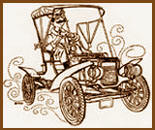Engine Instructions
Model A
Remanufactured Engine Block Instructions
- Do not attempt to start or run the engine without maintaining proper oil level and flow. We recommend 10W30 or 5W30 motor oils. The Model A engine with a steel camshaft and flat tappets performs well with new motor oils.
- Check oil flow immediately after starting engine. If gauge is not used, loosen lower oil pipe bolt. Oil should start to spurt out in the first minute and a half of running. If there is no oil after two minutes, turn engine off. Determine why there is no oil flow and repair as necessary.
- WARRANTY VOID if engine is run or operated without maintaining proper oil level and flow.
- Retorque head to 60 lbs. after first warm up, at 50 miles, 100 miles and 500 miles.
- Maximum timing advance is 28º. This is the point of no return and will promote longer bearing life.
- Do not attempt to start or run engine at any time without maintaining proper coolant level. We recommend the use of antifreeze and 1/2 vial of block sealer.
- WARRANTY VOID if engine is run or operated at excessive temperatures or without maintaining proper water level.
- All parts installed in or on engine are to be clean and in good working order. The cleaner the engine, the longer the life.
- ANTIQUE ENGINE REBUILDING is not responsible for damages occurring to engine or others due to use of worn, dirty, or faulty parts. This includes but is not limited to water pump, radiator, distributor, oil pump, oil pump drive gear, carburetor, belts, hoses, manifolds, gaskets, etc.
- Engine should always be maintained and operated according to manufacturer specifications.
- WARRANTY VOID if any part or parts assembled by the remanufacturer are disassembled by someone other than the remanufacturer, without notification.
Tips
- Add (3) quarts of oil to the crankcase and (1) to the valve chamber through distributor hole, (4) quarts total.
- 24 hours before starting, add one to two squirts of oil to cylinders through spark plug holes to lubricate cylinder walls, pistons, and rings.
- If all three are correct engine will start:
- Ensure proper spark.
- Ensure gas flow.
- Ensure proper timing.
- If after seven cranks engine is not running, check all items in #3 above. Excessive cranking can gas-wash cylinders, this can cause damage before engine is started.
- After starting, check for leaks, do not let engine over heat. Ensure proper water and oil levels and flows.
Things To Watch Out For
- Weak, broken or faulty spring and plunger.
- Proper length flywheel bolts.
- Remove dipper shelf from oil pan and clean bottom of oil pan underside of dipper shelf. Rinsing or soaking will not sufficiently clean parts.
- Do not idle engine to break in. This can cause loss of lubrication to cylinder walls and damage to engine.
- Avoid long cranking times. This can gas-wash cylinder walls, which causes loss of lubrication and can damage the engine.
- If using larger intake valves, ensure clearance between head and valve. The high compression Snyder's head that we sell does have ample clearance.
Notes
- Head gaskets are not warranted.
- Repairs made to engine and or car that are not due to our fault are chargeable, this can include diagnostic time.
